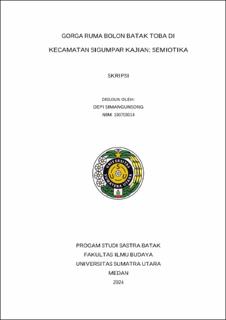Gorga Ruma Bolon Batak Toba di Kecamatan Sigumpar Kajian: Semiotika
Gorga Ruma Bolon Batak Toba in Sigumpar District Study: Semiotics

Date
2024Author
Simangunsong, Depi
Advisor(s)
Damanik, Ramlan
Herlina
Metadata
Show full item recordAbstract
This thesis is entitled “Gorga Ruma Bolon Batak Toba in Sigumpar District, Semiotic Study”. This research aims to describe the parts of Ruma Bolon, types of gorgas, forms of gorgas, functions and meanings of gorgas in the Toba Batak ethnic group. The theory used to analyze is the theory of semiotic studies. Peirce (Zoest 1978:1), said that semiotics is a branch of science that deals with the study of signs, such as sign systems and processes that apply to sign users. The method used in the research is a descriptive qualitative method. The results obtained from this research are: 1) there are 12 parts of the house bolon in Sigumpar District, namely Batu ojahan or house foundation, discussion or house pillars, rassang, balatuk or stairs, house windows, embers or under the house, sokkor, tataring or cooking place, floor of the house, walls of the ruma bolon, door of the ruma bolon, and roof of the ruma bolon, 2) there are 17 gorgas along with their functional forms and meanings, namely: Gorga Siture-ture, gorga Boraspati, gorga adop-adop or susu, gorga Singa -lion, Ipon-Ipon gorga, Sompi gorga, Mataniari or sun gorga, na ualu village gorga or eight cardinal points, Simarogung-ogung or gong gorga, ulu paung gorga, iran-iran gorga, silintong gorga, Sitangan-tangan gorga, gorga simeol-eol, gorga dalihan na tolu, gorga gaja dompak, gorga Jorngom or Jenggar. The conclusion of this research shows that Gorga is a traditional carving or carving which is usually found on the outside walls of houses and the front of traditional houses or also called gorga which contains mystical elements to determine the form, function and meaning of the Gorga ruma bolon in Sigumpar District.
Collections
- Undergraduate Theses [245]
